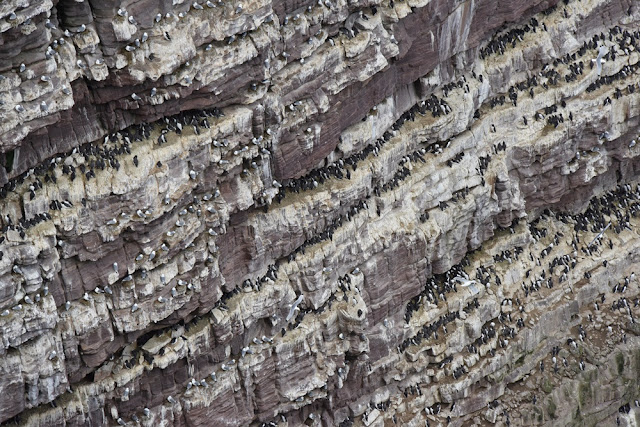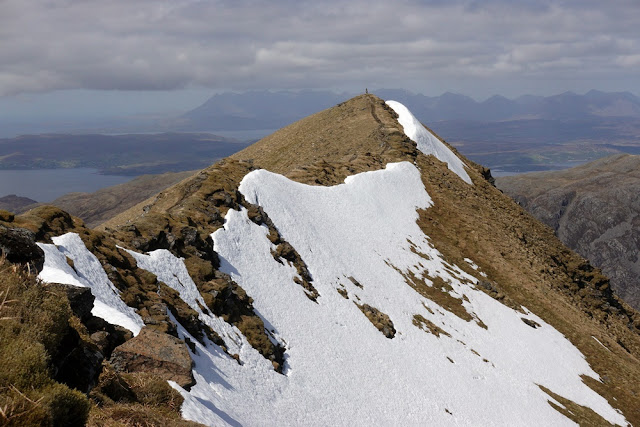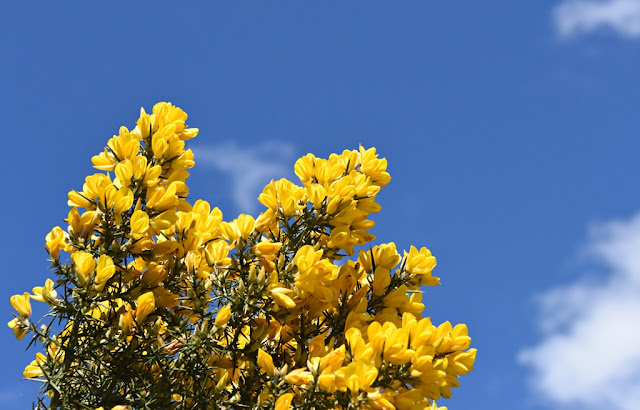Handa
I took a boat trip out to Handa last week, an island just offshore of the Sutherland west coast. The view above is of the island as seen from the shore at Tarbet, the ferry port. It's a low island, the highest hill only reaching 123m, but the northern and western sea cliffs are pretty spectacular.
The island is composed of Torridonian Sandstone, an ancient red sedimentary rock which has been weathered and battered by waves for millenia, to form deep geos and tall sea stacks.
The Great Stack is home to thousands of seabirds, as are the rest of the cliffs, and the setting at the mouth of a geo adds perspective to its height, which I couldn't find out, but must be about 40-50m.
Guillemots pack along the narrow ledges, several birds deep in places, and Kittiwakes perch their nests on even smaller ledges. Razorbills select to nest singly in small crevices or under boulders.
Many people go to the island to see Puffins, and there are some there, nesting in burrrows on the grassey ledges or cliff tops, but I spent my time watching the Fulmars gliding along the cliffs, flight perfected. They also nest on the grassy ledges near to top of the cliffs, so good views can be had of them without having to look down on tiny specks as with the Guillemots. Many of them were sitting in pairs, some would have had single eggs beneath them, but I never saw any. And they will be there til september, when their single chicks finally leave the nest, or rather their simple scape on a ledge.
They might only be simple scrapes on ledges, but what a neighbourhood to grow up in.
One Fulmar stalls in flight as it passes over another.
Then on the walk back to the ferry, the view was of the magnificent sandstone peaks of the Assynt hills on the mainland. An easy rewarding day.
The island is managed as a nature reserve by the Scottish Wildlife Trust .
Sunday, 27 May 2018
Wednesday, 23 May 2018
An Teallach - the Forge
Two days after I was high on Ladhar Bheinn, I had another good mountain day on An Teallach. This a massif south of Dundonnell in Wester Ross, and again a superb wild place. The above shot is of from left to right; Sail Liath, Stob Cadha Goblach, the Corrag Bhuidhe pinnalces and Sgurr Fiona, taken from the highest summit Bidein a'Glas Thuill (1062m).
Loch Toll an Lochan lies deep in its corrie on the east side of the range.
And over on the west, lie the Fisherfield hills, with Beinn Dearg Mor guarding Gleann na Muice.
The pinnacles of Corrag Bhuidhe make a striking jagged edge to the route around the tops, with looming depths on either side, especially into the lochan corrie.
It is being up high on such rocky ground that makes being in wild places like this so special.
Lord Berkely's Seat, an overhanging pinnacle on the crest of the ridge, is a particularly halting point when one looks down from that thin top.
Fortunately most of the ridge is walkable, or rather scramble-able, with a bit of climbing, and views out over the surrounding hills and glens come around every hidden bend or rise.
The pinnacles are quite wide on top in places, oh, about a full metre wide, with some tricky foot placements. And if you are lucky enough to get one, a strong cross-wind adds excitement.
These are all anthopocentric terms of course. The local wildlife, such as this pair of ptarmigan, they are unperturbed in their natural habitat, where they live all year round. What a life they have. I had to drop down in the afternoon for food and shelter.
The view looking back around the ridge from Sail Liath, to Bidein a'Glas Thuill.
I have been on this hill several times, I tried to re-count while up there, but I can't remember exactly as I didn't do all the tops on all the trips. But I do know I will go back at least once more. Well, this is one of the most dramatic hills in one of the wildest places in Scotland after all.
Two days after I was high on Ladhar Bheinn, I had another good mountain day on An Teallach. This a massif south of Dundonnell in Wester Ross, and again a superb wild place. The above shot is of from left to right; Sail Liath, Stob Cadha Goblach, the Corrag Bhuidhe pinnalces and Sgurr Fiona, taken from the highest summit Bidein a'Glas Thuill (1062m).
Loch Toll an Lochan lies deep in its corrie on the east side of the range.
And over on the west, lie the Fisherfield hills, with Beinn Dearg Mor guarding Gleann na Muice.
The pinnacles of Corrag Bhuidhe make a striking jagged edge to the route around the tops, with looming depths on either side, especially into the lochan corrie.
It is being up high on such rocky ground that makes being in wild places like this so special.
Lord Berkely's Seat, an overhanging pinnacle on the crest of the ridge, is a particularly halting point when one looks down from that thin top.
Fortunately most of the ridge is walkable, or rather scramble-able, with a bit of climbing, and views out over the surrounding hills and glens come around every hidden bend or rise.
The pinnacles are quite wide on top in places, oh, about a full metre wide, with some tricky foot placements. And if you are lucky enough to get one, a strong cross-wind adds excitement.
These are all anthopocentric terms of course. The local wildlife, such as this pair of ptarmigan, they are unperturbed in their natural habitat, where they live all year round. What a life they have. I had to drop down in the afternoon for food and shelter.
The view looking back around the ridge from Sail Liath, to Bidein a'Glas Thuill.
I have been on this hill several times, I tried to re-count while up there, but I can't remember exactly as I didn't do all the tops on all the trips. But I do know I will go back at least once more. Well, this is one of the most dramatic hills in one of the wildest places in Scotland after all.
Monday, 21 May 2018
Ladhar Bheinn - a true wild place
Ladhar Bheinn (hill of the hoof), pronounced Lar Ven, sits high (1020m) in the middle of the Knoydart peninsula in the west Highlands of Scotland. There is no public road into the area, so access is either by a long walk-in over rough hill paths, or by ferry from Knoydart. I have done the long walk in and out before, so this time I took the ferry.
Upper Coire Dhorrcail lies on the north-east side of the hill with great ridges sweeping down arround.
There was considerable late snow last winter and spring has been slow in coming, so there were some large snow patches hanging onto the summit slopes. The Cuillin in Skye lie on the horizon.
Ladhar Bheinn is in such a wild remote location, with wide views all around, especially on such a clear day as I had last week. Here, the small isles of Eigg and Rum fill the horizon, just south of Skye.
And the views down are also impressive. This shot is taken looking down a gully to the floor of Coire Dhorrcail, 300 m or more below. 1000ft in old money.
Here a group of high hill lochans lie on the north-western ridge. A landscape and view that has changed little since the ice-age over 10,000 years ago.
The satellite peak of Stob a' Choire Odhair overlooks the magnificent head waters of Loch Hourn and the hills of Glen Sheil beyond.
Yes, wild.
 |
| Ladhar Bheinn is the high ridge in the centre of this shot |
Upper Coire Dhorrcail lies on the north-east side of the hill with great ridges sweeping down arround.
There was considerable late snow last winter and spring has been slow in coming, so there were some large snow patches hanging onto the summit slopes. The Cuillin in Skye lie on the horizon.
Ladhar Bheinn is in such a wild remote location, with wide views all around, especially on such a clear day as I had last week. Here, the small isles of Eigg and Rum fill the horizon, just south of Skye.
And the views down are also impressive. This shot is taken looking down a gully to the floor of Coire Dhorrcail, 300 m or more below. 1000ft in old money.
Here a group of high hill lochans lie on the north-western ridge. A landscape and view that has changed little since the ice-age over 10,000 years ago.
The satellite peak of Stob a' Choire Odhair overlooks the magnificent head waters of Loch Hourn and the hills of Glen Sheil beyond.
Yes, wild.
Wednesday, 16 May 2018
Yellow
It's May, I'm in Scotland and the colour of the month is distinctly yellow. I was in the west coast Highland village of Badachro a few days ago where the Broom Cytisus scoparius and Gorse Ulex europaeus were spilling over with flowers.
These shrubs are spectacular en masse, but the detail of the Broom flowers is just as impressive.
The Gorse looked vibrant when viewed against the full blue sky from low down.
And the detail of the Gorse flowers, tightly packed into clusters, was picked out by backlight.
Meanwhile, down at ground level, the Lesser Celandine Ranunculus ficaria flowers were glistening amongst the remains of last year's oak leaves and fern fronds.
The Celandine petals simply radiated yellow.
And Dandelions Taraxicum officinale, such valuable food plants, provided an early source of nectar for insects.
Yellow - what a wonderful colour.
It's May, I'm in Scotland and the colour of the month is distinctly yellow. I was in the west coast Highland village of Badachro a few days ago where the Broom Cytisus scoparius and Gorse Ulex europaeus were spilling over with flowers.
These shrubs are spectacular en masse, but the detail of the Broom flowers is just as impressive.
The Gorse looked vibrant when viewed against the full blue sky from low down.
And the detail of the Gorse flowers, tightly packed into clusters, was picked out by backlight.
Meanwhile, down at ground level, the Lesser Celandine Ranunculus ficaria flowers were glistening amongst the remains of last year's oak leaves and fern fronds.
The Celandine petals simply radiated yellow.
And Dandelions Taraxicum officinale, such valuable food plants, provided an early source of nectar for insects.
Yellow - what a wonderful colour.
Subscribe to:
Posts (Atom)






























